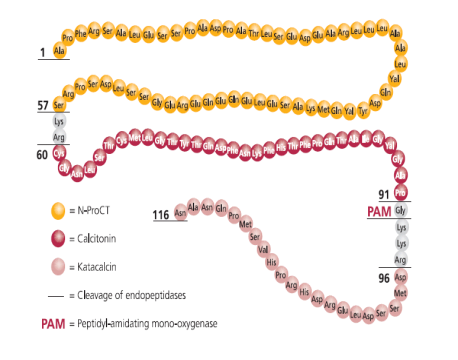Similarities and Differences between the Approaching Procalcitonin (PCT) and Calcitonin (CT)
Procalcitonin (PCT) and calcitonin (CT) are two commonly used biomarkers in clinical practice. PCT is encoded by the Calc-I gene on chromosome 11, which first generates procalcitonin precursors in the rough endoplasmic reticulum of thyroid follicular cells, and then forms PCT through glycosylation and enzymatic cleavage. It has a total of 116 amino acid sequences, including 1-57 being N-residues, 60-91 being calcitonin, and 96-116 being calcitonin. CT is formed by further degradation and C-terminal amidation.

PCT amino acid structure
It is not difficult to see that procalcitonin PCT is a precursor to calcitonin CT. There is a certain connection between the two in biosynthesis, although there is only a one word difference, there are significant differences in biological characteristics and clinical applications: PCT is a glycoprotein that does not have hormonal activity and is commonly used as an important indicator for the diagnosis and monitoring of bacterial infections and sepsis; As a hormone, CT is a biomarker for the diagnosis and monitoring of medullary thyroid carcinoma and malignant tumors, and can also be used for the diagnosis and treatment of osteoporosis.
Different biological characteristics
PCT is a glycoprotein composed of 116 amino acids with a relative molecular weight of 13 × 103. It does not have hormonal activity and stably exists at extremely low levels in healthy individuals. When the body experiences severe bacterial, fungal, parasitic infections, sepsis, and multiple organ failure, PCT forms in large quantities in various tissues and organs, rapidly releasing into the circulatory system.
PCT is a peptide hormone composed of 32 amino acids produced and secreted by parafollicular cells (also known as bright cells or C cells) of the thyroid gland. It is equally important in regulating calcium and phosphorus metabolism as parathyroid hormone (PTH) and vitamin D. Calcitonin has certain biological effects on bones, kidneys, central nervous system, respiratory system, gastrointestinal tract, and reproductive system. However, its receptors are mainly distributed in bones and kidneys, and its main function is to reduce blood calcium and phosphorus concentrations. It is an antagonist of parathyroid hormone. Mature calcitonin plays an important role in bone homeostasis and is an important regulatory factor for bone resorption.
Different clinical significance
PCT:
1. The expert consensus on the emergency clinical application of procalcitonin (PCT) indicates that PCT has been recommended for the diagnosis, stratification, treatment monitoring, and prognosis evaluation of bacterial sepsis.
Suggestions on the interpretation of PCT results in the Consensus ↓
| PCT concentration (ng/ml) | Clinical significance |
| <0.05 | Normal value |
| <0.5 | No or mild systemic inflammatory response; Possible local inflammation or infection |
| 0.5~2 | Moderate systemic inflammatory response. Possible infection or other conditions, such as severe trauma, major surgery, cardiogenic shock |
| 2~10 | It is likely to be sepsis, severe sepsis, or septic shock. Has a high risk of organ dysfunction |
| ≥10 | Almost all cases are severe bacterial sepsis or septic shock. Often accompanied by organ failure, with a high risk of death |
2. Differential diagnosis of bacterial and non bacterial infections and inflammation, compared to bacterial or fungal infections, viral infections have lower PCT concentrations.
3. The PCT value is correlated with the severity and spread range of bacterial infections, which can be used to evaluate the severity of bacterial infections, distinguish local or systemic infections, and also assess the risk of death in sepsis patients.
4. Evaluation of antibiotic efficacy and guidance on antibiotic use.
Recommendation of PCT for anti infection in patients with lower respiratory tract bacterial infections ↓
| Medication and discontinuation indications | PCT concentration (ng/ml) |
| Timing of medication | PCT>0.25 |
| Timing of discontinuation of medication | Non severe: PCT ≤ 0.25 or a decrease of more than 80% from the peak PCT Severe illness: PCT ≤ 0.5 or a decrease of more than 80% from the peak PCT |
5. Monitor patients at risk of infection and critically ill patients, such as postoperative patients, acute pancreatitis, chronic kidney disease, etc.
CT:
1. It is a sensitive tumor marker for diagnosing medullary thyroid carcinoma (MTC). Without stimulation, serum CT>100pg/ml indicates the possible presence of MTC and can also serve as an indicator of treatment efficacy. When treatment is effective, CT significantly decreases.
2. It is used to observe the curative effect of malignant tumors and judge the prognosis, such as thyroid cell benign adenoma, primary hyperthyroidism, ectopic calcitonin tumor, small cell lung cancer, uterine cancer, breast cancer, prostate cancer, and tumor bone metastasis. It can be used as an activity indicator of malignant tumors.
3. As a biomarker for osteoporosis, it determines the metabolic status of bone. Pregnant women and children have elevated serum CT levels due to bone growth; After menopause, serum CT levels decrease in women with low blood calcium and age-related osteoporosis.
4. Used for auxiliary diagnosis of benign and malignant thyroid nodules.
In summary, procalcitonin and calcitonin are two completely different biomarkers, showing significant differences in multiple aspects, with the difference between the two far exceeding a single word.
| biomarkers | Procalcitonin (PCT) | Calcitonin (CT) |
| structure | 116 amino acids (N-ProCT, CT, Kata) | 32 amino acids (CT) |
| nature | glycoprotein | Peptide hormones |
| clinical application | Diagnosis and monitoring of bacterial infections and sepsis; Antibiotic guided medication | MTC, diagnosis and monitoring of malignant tumors; Diagnosis and treatment of osteoporosis |
| For the crowd | Infected patients | MTC, tumor patients: osteoporosis population |
| Applicable departments | Emergency department, internal medicine, respiratory department, ICU, etc | Orthopedics, Endocrinology, Thyroid Surgery, etc |
The hospital examination time is different
PCT: Check at any time, report within 2 hours after specimen collection.
CT: Fasting examination, submitted before 11am daily, report before 15am on the same day.

















